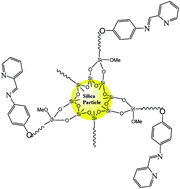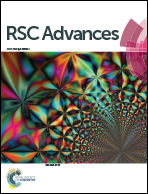An inorganic–organic hybrid material made of a silica-immobilized Schiff base receptor and its preliminary use in heavy metal removal
Abstract
A novel and excellent host for heavy metals was synthesized by chemical immobilization of a (E)-4-((pyridin-2-yl-methylene)amino)phenol Schiff base receptor onto silica particles. The new hybrid material (SPSB) was analyzed and evaluated by elemental analysis, FT-IR spectroscopy, solid-state 13C NMR, scanning electron microscopy, BET surface area and BJH analyses. The surface exhibits good thermal stability determined by thermogravimetry and good chemical stability examined in various acidic and buffer solutions (pH 1–7). The coordination ability of SPSB was found to be most efficient in the pH range 6.5–8 for Hg2+, Cd2+, Pb2+ and Zn2+. Alkali coexisting ions did not interfere with separation and determination. The adsorbent can be regenerated at ease without destruction. Heavy metal removal performance (99 mg g−1) was found to be higher compared to previous literature reports.


 Please wait while we load your content...
Please wait while we load your content...